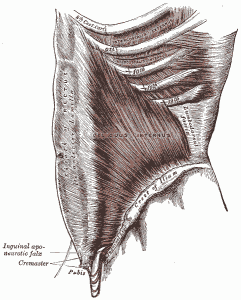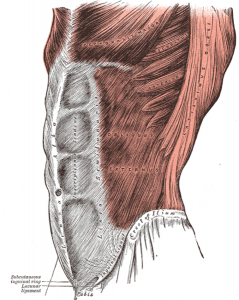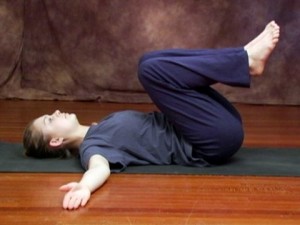Internal and external oblique muscles are the muscles twisting in the pose below. If I were told that I could only do one pose/asana/exercise for the rest of my life it would be the pose in the pictures—Jathara Parivartanasana. This core twist serves all parts of the body and particularly works the internal and external oblique muscles of the abdomen.
The internal oblique has a number of functions—it works against the diaphragm to help reduce the volume of air in the lungs during exhalation as well as aiding in rotation and bending the trunk to the side with the help of the external oblique muscle.
The external oblique also has a number of functions aiding in rotation as well forward and backwards flexion depending upon the pull of the muscle in a given action.
Many of my clients are extremely tight between the pelvis and the rib cage and have a great deal of trouble twisting the internal and external oblique muscles. This tightness affects all parts of the body.
- It restricts the natural rotation we are looking for when walking.
- It limits the ability to achieve full deep breaths
- It affects the hip and knee joint which require reciprocal movements from the spine to walk effectively.
Jathathara Parivartasana- Supine Core Twist
There is a lot going on in this pose. The inner thighs should stay glued together and the shoulders are resisting the urge to pull off the floor as the legs go over to the opposite side.
- Lie down on your mat on your back. Bring your arms out to the side with the wrists at the height of the shoulders, like the letter T. Turn your palms up towards the ceiling.
- Draw your knees up towards your chest.
- Pulling the knees up, bring your knees towards the right elbow.
- Looking straight up the whole time, keep the legs together and slowly come back up to the center.
- In slow motion, move the knees to the left, again drawing them up towards the elbow.
- Coming back up to the center, keep squeezing the legs together and bring the knees up towards the nose.
- To go deeper in this exercise, you’re going to come over to the right again and stop about two-thirds of the way down. Stop, hold, and squeeze the legs together and release the left side of the rib cage down towards the floor. Come back up to center slowly. Move to the left on an angle as slowly as you can, stop two-thirds of the way, hover and at the same time reach the right side of the rib cage down towards the floor.
- To go deeper still, the full pose is done with straight legs. The difficulty in this advanced version is keeping the legs straight, together, and moving up on an angle towards the finger tips. If the legs can’t move on an angle towards the fingers you should only do this with the knees bent.
I spend my day watching the wrinkles in people clothing, particularly shirts. When people walk and their shirts don’t wrinkle as they twist, the internal and external oblique muscles are not working as well as they could.




